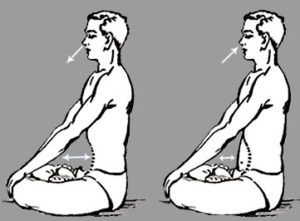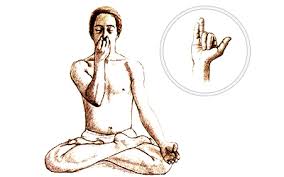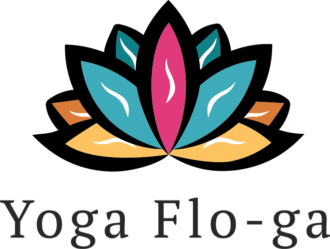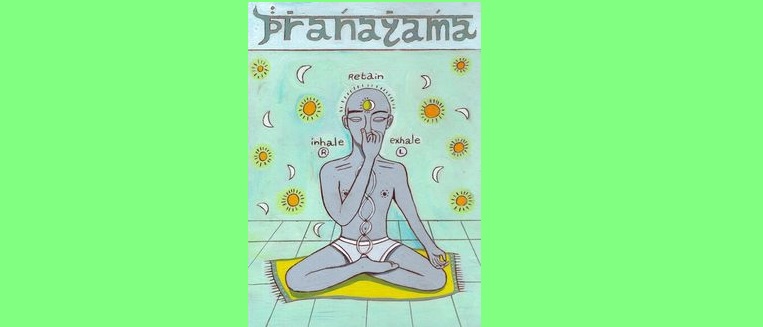One of the main Life Forces (prana) of our bodies is governed by our Breath. This means that if our breath is “unhealthy” – fast, short, shallow; then our bodies struggle to stay healthy. We encounter stress, tense muslces, lack of oxygen which can impair our mental capabilites and our bodies abilities to heal, just to name a few.
Breathing is something we do subconsciously, however if we can work on being conscious breathers, working on keeping our breaths slow, long and deep, we help to provide the foundations for maintaining a healthy balance in our bodies.
As with any exercises, practice is the most important thing. This is why breathing practices are called Pranayama.
Types of Prana
- Prana Vayu: Governs the area of the head. The process of reception; of food, drink, air and sensory input
- Apana Vayu: Governs the lower abdomen. The process of elimination; of urine, faeces, semen, mentral flow, negative mental and emotional experience
- Udana Vayu: Governs the neck and throat. The processes of speech and expression; allows for growth, effort and enthusiasm
- Samana Vayu: Governs the navel. The process of digestion; food, air and emotional/mental experience
- Vyana Vayu: Governs the heart and lungs. The process of circulation; blood/oxygen, food, water and thoughts
Exercising the Breath – Breathing Techniques
The different types/styles of Pranayama work on the different types of Prana. Just as when exercising our muscles we use different types of exercises for the different parts of the body.
Below I will go into 4 different techniques, however these are the common ones and there are lots of different ones out there if you are interested in persuing a futher understanding, or broadening the scope of your practice
- Deep Abdominal Breathing
Method: Sitting/ lying comfortably, direct the breath into the abdominal area. Inhaling and exhaling as deeply as you can allowing the abdominal area to balloon out and then contract towards the lower spine. Keeping the inhale and exhale the same length. 3-4 seconds to start, extending it to longer as your lung capacity and endurance improve
Benefits: Brings air to the lowest part of the lungs (that we often don’t use), exercises the diaphragm, calms the mind and slows the heart rate, aiding with stress
2. Full Yogic Breath (4-Part Breath)
Method: Sitting/ lying comfortably, resting right hand on the abdomin and the left hand on the chest. Inhale slowly into the abdominal area, feeling as it expands like a balloon and the hand resting there pushes out. Still inhaling continue to breathe into the chest, feeling the ribcage expand to the front and sides. Continue breathing into the clavicles (collar bones) until the lungs are at their full capacity. Exhale slowly to the base of the spine. Keeping the inhale and exhale the same length. To start it is often a good idea to count into each area – Inhale 1,2 stomach; 1,2 lungs; 1,2 collar bones; exhale 1,2,3,4,5,6.
Benefits: Learning to control your breath, expanding lung capacity and endurance. Exercising the diaphragm and intercostal muscles and the neck with clavicular breathing. Calms the mind and slows the heart rate, aiding with stress
3. Kapalabalti (Shining Skull)
Often practiced in a hot yoga class, so one that a few of you might be more familiar with.
 Method: Sitting cross-legged, straight spine, eyes closed. Take a few Yogic Breaths to prepare. Then using the abdominal muscles exhale; short and sharp. Allow the body to naturally inhale. The exhale should have an almost whistling sound as you push the air out, and the inhale should be quiet and calm.
Method: Sitting cross-legged, straight spine, eyes closed. Take a few Yogic Breaths to prepare. Then using the abdominal muscles exhale; short and sharp. Allow the body to naturally inhale. The exhale should have an almost whistling sound as you push the air out, and the inhale should be quiet and calm.
This can be a bit strange as you are reversing the natural order of an active inhale/passive exhale and are rather working towards a passive inhale/active exhale. While you get used to this motion it is often the case that you try to force the inhale, or don’t inhale at all causing you to become short of breath and to feel slightly dizzy.
The inhale/exhale can be done either through the mouth or the nose. I often do a few sets of each. It will be louder when practiced with an open mouth. Each set should be between 30-100 exhales, depending on your stamina and breath. 3-5 sets at a time with a few full Yogic Breaths between each set, only pumping so far as feels comfortable.
The pace of the breath should be challenging but comfortable. Rather work on ensuring you are using your abdominal muscles to pump the air out rather than on how fast you can do it. Once you have a really good flow, then start speeding up the space.
Ensure that you are only using your abdominal muscles and not your whole body to pump the air out. The spine/shoulders should not move with the breath. Only your ribcage, lungs and abdominals.
The hands can sit palm down on your knees, or personally I prefer to keep them in Chin Mudra – thumb and forefinger touching, palms face up.
Benefits: Cleansing the lungs of stale air and toxins. Purifies the nasal passages, brochial tubes and lungs. Eliminates excess carbon dioxide. Bringing fresh supply of oxygen to the body and brain. Works the abdominal muscles. Trains your mind.
4. Anuloma Viloma/ Nadi Shodhana (Alternate Nostril Breathing)

Method: Sitting cross-legged, spine straight, eyes closed. Right hand in Vishnu Mudra (index and middle fingers tucked into the palm). Left hand in Chin Mudra on the knee.
Exhale fully through both nostrils. Keeping the right hand in Vishnu Mudra use the thumb to close the right nostril and inhale through the left nostril. Pinch both nostrils closed with the thumb and ring finger. Release the right nostril and exhale. Inhale through the right. Pinch both. Exhale through the left.
This is one round. The breath counts are inhale for 4 and exhale for 8. You can also hold the breath for a few counts during the pinch. Keeping the ration 1:2 Inhale:Exhale, you can lengthen or shorten the breath to suit you. Repeat 8-12 rounds making one set. Do 1-5 sets with deep Yogic Breath between.
The watchout here is that you start to curl your spine forward or tilt your head down into your hand. Ensure your spine and head stay straight and up and that you bring your hand to your nose. Keeping the elbow elevated with the bicep parrallel to the ground if possible.
Benefits: Correct habits of shallow breathing. Balance the two sides of the brain and the energy system within and around our bodies. Prepares you for more advanced pranayama and meditation. Aids with co-ordination. Holding the breath can prolong life (according to yogic philosophy) Works the arm muscles in the right arm.
Other Thoughts
Pranayama is just one aspect of keeping the body and mind balanced and healthy. As mentioned in previous posts, there are lots of other aspects such as Asana, Meditation and Kriya’s. Take it one step at a time and slowly build it up. Life is about practice and trying to be the best version of ourselves every day.
All breathing techniques can be taken into our daily lives, they help us to remain calm, centred and give us a tool to use to deal with stress. With practice they become easier and therefore finding that calm head space becomes easier.
Happy Breathing!


It’s nearly impossible to find knowledgeable people in this particular topic, however, you seem like you know what you’re talking about! Thanks|